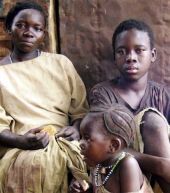Sudan abductees start new life in south
By Opheera McDoom
MALWALKUON, Sudan, March 7 (Reuters) – Skinny Santino Atem Akok was kidnapped 16 years ago from his home in southern Sudan by armed horse-riding Arabs from the north and made to work like a slave without pay.

|
|
Susana John, 22 and her daughter of 4 and an unidentified relative are seen in Wau, southern Sudan Wednesday March 2, 2005. John’s husband was killed in September, 2001 in fighting over the town of Raja, northwest of Wau. (AP). |
But last year he returned to his hometown of Malwalkuon by a government-appointed group and is training to become a mason.
“There was no way I could escape them by myself; they were very hard on us,” Akok told Reuters, wiping cement from his hands.
“They would make us work all day tending to cattle and if we did not work hard enough they would beat us and we would not get food,” said the tall but scrawny member of the Dinka tribe.
Akok is now 27, but since his abduction when he was 11 years old he has had no education. On his return last year he found all his family had either fled or been killed.
“I heard that my mother had been killed by the Murahileen (Arab nomad militias),” he said, shaking his head.
With nowhere to go, Akok sleeps in the centre where he trains. The centre only has funding for 56 students at a time, but thousands of people who had been abducted have been returned to Malwalkuon already this year.
Every year another set of students are taken on to be trained in vocations such as masonry and carpentry.
But aid workers are swamped by an average of about 400 people returning everyday to this area of the south, after hearing the news a peace deal had ended more than two decades of civil war in the region.
Hunger and disease claimed the lives of about 2 million people and more than 4 million fled their homes during the fighting between the Islamist Khartoum-based government and the mostly pagan and Christian rebels in the south.
On top of the returnees, a government-appointed committee is also finding kidnapped children and bringing them back home.
A teacher at the centre Santino Anyuan said the Committee for the Eradication of the Abduction of Women and Children (CEAWC) was doing a great job. “These people have suffered and they are so happy to come back,” he said.
OPERATIONS SUSPENDED
But the United Nations has expressed concern over the methods used by CEAWC, saying some of those being returned were being forced to come back and others were being dumped in the south with no help to find their families.
The U.N. humanitarian coordinator for Sudan, Manuel Aranda da Silva, said the U.N. had agreed with CEAWC to suspend their work until a new system was formed to tackle these problems.
“Fifteen percent of the people were not willing to come back because they had become part of families — 85 percent were genuine cases,” he said.
Da Silva said he wanted advice and assistance to be given to the abductees. He said CEAWC had suspended operations until the end of April.
Sudan in the 19th century was a centre for the slave market with northern Arab tribes acting as middle men for the worldwide slave trade. But abductions have continued, with mostly Arab tribes taking children from the non-Arab tribes of Sudan’s southern and western regions.
